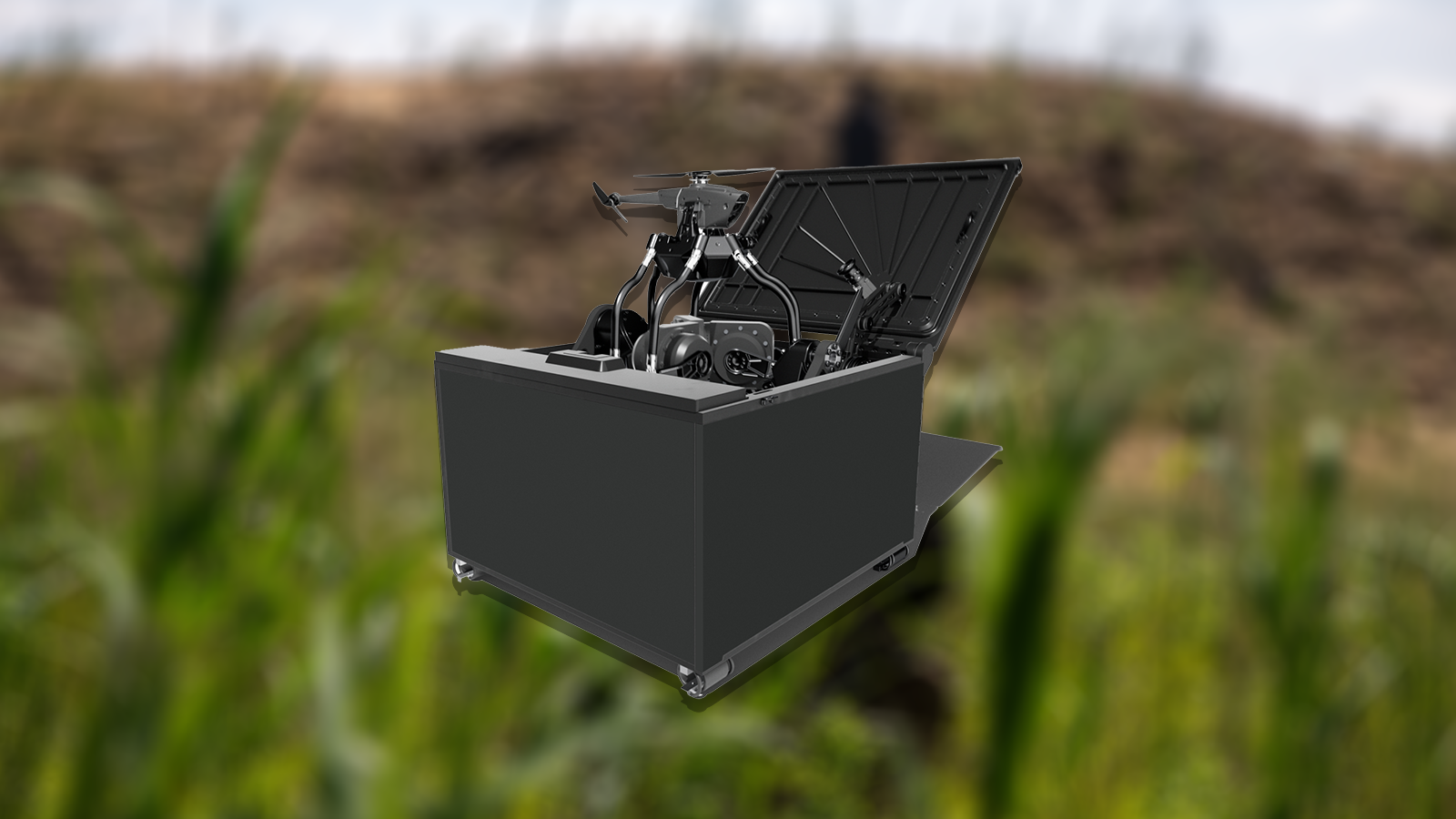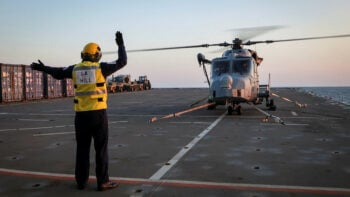
Teledyne-FLIR unveils “Black Recon” vehicle drone system. (Teledyne-Flir, DVIDS background image)
DSEI 2023 — On the battlefield, Ukrainian armed forces can already operate hundreds of pocket-sized Black Hornet 3s, using the nano-UAVs for reconnaissance, surveillance and targeting, according to maker Teledyne FLIR.
Now, here at the Defence Security and Equipment International expo in London, Teledyne is unveiling what it says is the next iteration of its broader family of autonomous tech: the ‘Black Recon’ Vehicle Reconnaissance System (VRS), designed to autonomously launch and recover a larger, new variant of the Black Hornet UAV.
The platform has been in development for nearly five years, often in close cooperation with the Norwegian Ministry of Defense, FLIR’s senior director of business development, Ketil Vanebo explained to Breaking Defense before DSEI.
“Black Recon sends live imagery and targeting information back to vehicle crews,” Vanebo said. “Operators can use the system for a wide range of missions, such as assessing if terrain is passable, sweeping for mines and improvised explosive devices, or performing close-up inspection under bridges using onboard illumination. The system delivers high precision RSTA [recon, surveillance and target acquisition] and can perform GPS-denied operations.”
FULL COVERAGE: Breaking Defense at DSEI 2023
Comprising a box that’s bolted onto the chassis of a tactical ground vehicle, the Black Recon VRS weighs less than 80 kilograms and carries three specially designed micro-UAVs, charging port, and launch and recovery module that wouldn’t look out of place on board a spaceship. The VRS is controlled from inside the vehicle, meaning vehicle crews are not required to leave the safer confines of the cabin, thereby enhancing their survivability on the battlefield, Vanebo said.
Interestingly, the VRS does not feature Teledyne FLIR’s Black Hornet 3 nano-UAV, which Ukraine received as part of an aid package courtesy of Norway. Instead, the company has designed a larger but still micro-UAV, which will weigh approximately 350 grams (10 times heavier than the legacy Black Hornet UAVs) and is akin to a sneaker in size. This means it can carry a larger battery which ensure the UAV can fly for more than 45 minutes at a maximum range of six kilometers from the vehicle, Teledyne says, three times the Black Hornet’s max range.
“While the Black Hornet line represents the ultimate in low SWaP [size, weight and power], low signature, and indoor capability. The Black Recon UAV shifts the focus more towards speed, robustness, and payload capability, while still having an impressively low signature,” Vanebo said.
RELATED: Dumb and cheap: When facing electronic warfare in Ukraine, small drones’ quantity is quality
Equipped with an electro-optical camera and pair of long-wave infrared (LWIR) cameras, Black Recon UAVs are controlled via Teledyne FLIR line-of-sight datalink technology, meant to allow them to operate “beyond the engagement envelope” of many combat vehicles and anti-tank weapons, Vanebo added.
“The system is designed to provide continuous, untethered reconnaissance with the speed to work ahead of advancing vehicles and provide situational awareness, even beyond line-of-sight,” he said.
Upon mission completion, the UAV returns to the host vehicle for autonomous recovery by Black Recon’s unique, cradle-arm capture system, which features several motorized actuators moving in different directions at the same time.
“We use a proprietary tracking system that employs LED technology with a SWIR camera and advanced tracking algorithms developed in-house for extremely precise tracking. Precision is very high and we are talking about less than five millimeters,” Vanebo explained.
RELATED: Teledyne-FLIR merger creates tactical drone powerhouse
Once recovered, the next UAV can be immediately launched to take over a mission while the remaining two UAVs are recharged in less than 45 minutes and prepared for their next rotation when required. Alternatively, a second UAV could be deployed to maintain continual ‘eyes on’ target while the first returns to the base for recharging.
According to Vanebo, Black Recon can be integrated into the battle management system of a vehicle or operated in a standalone configuration, dependent upon customer requirements.
“The Norwegian MoD had a requirement for better situational awareness to see what was ahead of their vehicles on the battlefield,” Vanebo said.
“The system will deliver benefits for several vehicle types — everything from infantry fighting vehicles and main battle tanks to engineering and logistics units. We are in continuous contact with larger OEMs in the US, Europe and Asia and are seeing a lot of interest and working on several opportunities. We think this is going to be a big change as we see UAVs becoming the first sensor to detect activity on the battlefield,” Vanebo said.
In 2018, Teledyne FLIR Defense first considered the design and development of a VRS featuring the legacy Black Hornet nano-UAV, but conceded this particular airframe was optimized for the dismounted soldier and therefore not an ideal fit for vehicle operations.
“Integrations and field trials we completed with the Black Hornet VRS were important for gathering feedback and refining the final requirements for [Black Recon],” Vanebo suggested.
Black Recon is expected to be available to customers in the second half of 2024 with initial deliveries likely to take place in “early 2025,” he concluded.
Vanebo said it would be premature to comment on whether Black Recon would be supplied to the Ukrainian Armed Forces.






















